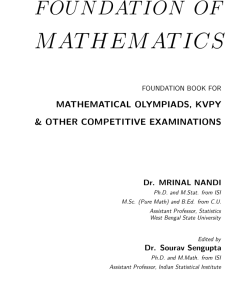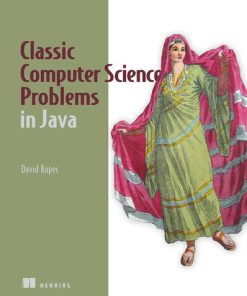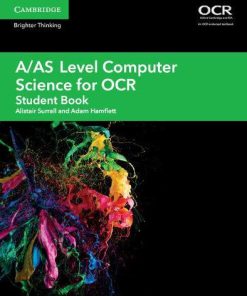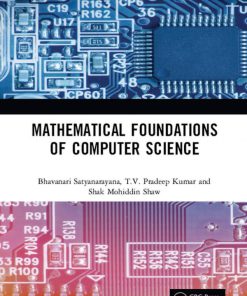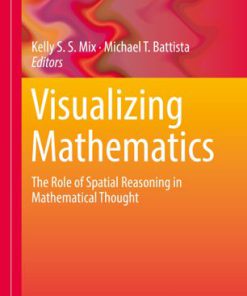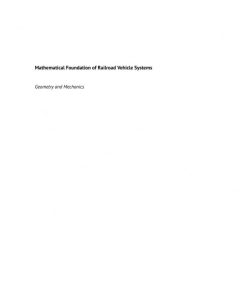A Mathematical Foundation for Computer Science 1st edition by David Mix Barrington 9781792437601 1792437609
$50.00 Original price was: $50.00.$25.00Current price is: $25.00.
A Mathematical Foundation for Computer Science 1st edition by David Mix Barrington – Ebook PDF Instant Download/Delivery:9781792437601,1792437609
Full download A Mathematical Foundation for Computer Science 1st edition after payment
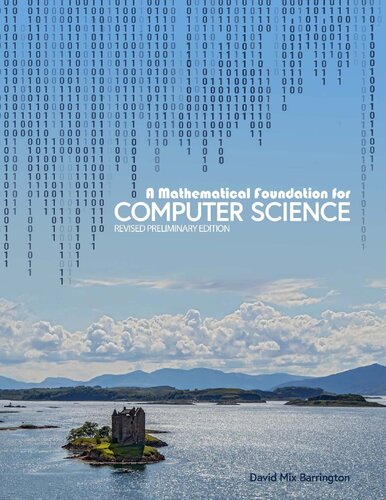
Product details:
ISBN 10:1792437609
ISBN 13:9781792437601
Author:David Mix Barrington
Undergraduate computer science students need to learn and use the mathematical method of abstraction, definition, and proof, perhaps even earlier than do mathematics students. They deal constantly with formally defined systems beyond those studied in mathematics courses, and must be able reason about them formally in order to write and understand programs. A Mathematical Foundation for Computer Science introduces the mathematical method using examples from computer science, often illustrated by Java-like code. It begins with propositional and predicate logic, introduces number theory, and deals thoroughly with mathematical induction as it relates to recursive definition and recursive algorithms. Later chapters cover combinatorics, probability, graphs and searching, finite-state machines, and a brief introduction to formal language theory. Each chapter is divided into narrative sections, each with Exercises and Problems, and Excursion sections suitable for active learning exercises. This preliminary edition includes the first four chapters, used as the textbook for the first half of a UMass course, COMPSCI 250.
A Mathematical Foundation for Computer Science 1st Table of contents:
Chapter 1: Sets, Propositions, and Predicates
1.1 Sets
1.2 Strings and String Operations
1.3 Excursion: What Is A Proof?
1.4 Propositions and Boolean Operations
1.5 Set Operations and Propositions About Sets
1.6 Truth-Table Proofs
1.7 Rules For Propositional Proofs
1.8 Propositional Proof Strategies
1.9 Excursion: A Murder Mystery
1.10 Predicates
1.11 Excursion: Translating Predicates
Chapter 2: Quantifiers and Predicate Calculus
2.1 Relations
2.2 Excursion: Relational Databases
2.3 Quantifiers
2.4 Excursion: Translating Quantifiers
2.5 Operations on Languages
2.6 Proofs with Quantifiers
2.7 Excursion: Practicing Proofs
2.8 Properties of Binary Relations
2.9 Functions
2.10 Partial Orders
2.11 Equivalence Relations
Chapter 3: Number Theory
3.1 Divisibility and Primes
3,2 Excursion: Playing With Numbers
3,3 Modular Arithmetic
3.4 There Are Infinitely Many Primes
3.5 The Chinese Remainder Theorem
3.6 The Fundamental Theorem of Arithmetic
3.7 Excursion: Expressing Predicates in Number Theory
3.8 The Ring of Congruence Classes
3.9 Finite Fields and Modular Exponentiation
3.10 Excursion: Certificates of Primality
3.11 The RSA Cryptosystem
Chapter 4: Recursion and Proof By Induction
4.1 Recursive Definition
4.2 Excursion: Recursive Algorithms
4.3 Proof By Induction for Naturals
4.4 Variations on Induction for Naturals
4.5 Excursion: Fibonacci Numbers
4.6 Proving the Basic Facts of Arithmetic
4.7 Strings and String Operations
4.8 Excursion: Naturals and Strings
4.9 Graphs and Paths
4.10 Trees and Lisp Lists
4.11 Induction for Problem Solving
Chapter 5: Regular Expressions and Other Recursive Systems
5.1 Regular Expressions and Their Languages
5.2 Examples of Regular Languages
5.3 Excursion: Designing Regular Expressions
5.4 Proving Regular Language Identities
5.5 Proving Properties of the Regular Languages
5.6 Excursion: Hofstadter’s MU-Puzzle
5.7 Recursion and Induction in General
5.8 Top-Down and Bottom-Up Definitions
5.9 Excursion: Parsing Arithmetic Expressions
5.10 A Recursive Definition of Imperative Programs
5.11 Correctness of Imperative Programs
Chapter 6: Fundamental Counting Problems
6.1 Counting: Sum and Product Rules
6.2 Double-Counting and Inclusion/Exclusion
6.3 Counting Sequences (First Counting Problem)
6.4 Counting Permutations (Second Counting Problem)
6.5 Excursion: The Problem of Sorting
6.6 Counting Subsets of a Set (Third Counting Problem)
6.7 Counting Multisets (Fourth Counting Problem)
6.8 Excursion: Listing Permutations and Combinations
6.9 Counting Strings in Languages
6.10 Counting Balanced Strings of Parentheses
6.11 Excursion: Catalan Numbers
Chapter 7: Further Topics in Combinatorics
7.1 Recurrences
7.2 Solving Some Recurrences
7.3 Excursion: Calculus on Sequences
7.4 Generating Functions
7.5 Asymptotic Notation
7.6 Analysis of Sorting
7.7 Excursion: Selection Problems
7.8 Cardinality of Infinite Sets
7.9 Diagonalization and Uncountability
7.10 Excursion: Ordinal Arithmetic
7.11 Combinatorial Games
Chapter 8: Graphs
8.1 Graph Definitions
8.2 Adjacency Matrices
8.3 Paths and Matrix Powering
8.4 Excursion: Min-Plus Matrix Powering
8.5 Dynamic Programming
8.6 Euler and Hamilton Paths
8.7 Excursion: Classifying Graphs
8.8 Vertex and Edge Colorings
8.9 Graph Planarity
8.10 Excursion: Euler’s Formula for Polyhedra
8.11 Trees as Graphs
Chapter 9: Trees and Searching
9.1 Trees and Their Uses
9.2 Excursion: Boolean Expressions
9.3 Recursion on Trees
9.4 General Search Trees
9.5 General Breadth-First and Depth-First Search
9.6 BFS and DFS on Graphs
9.7 Excursion: Middle-First Search and Matrices
9.8 Uniform-Cost Search
9.9 A* Search
9.10 Games and Adversary Search
9.11 Excursion: Hexapawn
Chapter 10: Discrete Probability
10.1 Probability Distributions
10.2 Expected Value
10.3 Evaluating Games
10.4 Excursion: Analysis of Craps
10.5 Variance and Standard Deviation
10.6 The Binomial Distribution
10.7 Excursion: Election Polling
10.8 The Coupon Collector’s Problem
10.9 The Markov and Chebyshev Bounds
10.10 Excursion: Contention Resolution
10.11 The Union Bound
Chapter 11: Reasoning About Uncertainty
11.1 Conditional Probability and Bayes’ Theorem
11.2 Odds and Likelihood
11.3 Examples of Bayesian Reasoning
11.4 Excursion: A Police Lineup
11.5 The Naive Bayes Classifier
11.6 Problems With the Naive Classifier
11.7 Graphical Models of Distributions
11.8 Excursion: A Probabilistic Murder Mystery
11.9 Pseudorandom Generators
11.10 Monte Carlo Simulation
11.11 Excursion: Simulating Baseball Seasons
Chapter 12: Markov Processes and Classical Games
12.1 Finite-State Random Processes
12.2 Markov Chains
12.3 Limiting Behavior of Markov Chains
12.4 Excursion: Markov Text Generation
12.5 Markov Decision Processes
12.6 Horizons and Discounting
12.7 Value and Policy Iteration
12.8 Excursion: Modeling Blackjack
12.9 Two-Player Simultaneous-Move Games
12.10 Excursion: Modeling Baseball Balls and Strikes
12.11 The Prisoners’ Dilemma
Chapter 13: Graphs
13.1 What Is a Bit?
13.2 Data Compression
13.3 Excursion: Redundancy of English Text
13.4 Variable-Length Codes
13.5 Excursion: Huffman’s Algorithm
13.6 Huffman Coding and Entropy
13.7 Error-Detecting Codes
13.8 Error-Correcting Codes
13.9 Excursion: Experimenting With Codes
13.10 Conditional Entropy and Noise
13.11 The Noisy-Channel Theorem
Chapter 14: Finite-State Machines
14.1 Deterministic Finite Automata
14.2 Proving that DFA’s Can’t Do Things
14.3 The Myhill-Nerode Theorem
14.4 Excursion: Syntactic Monoids
14.5 Nondeterministic Finite Automata
14.6 The Subset Construction: NFA’s into DFA’s
14.7 Killing λ-Moves: λ-NFA’s into NFA’s
14.8 Constructing λ-NFA’s from Regular Expressions
14.9 Excursion: Practicing Multiple Constructions
14.10 State Elimination: NFA’s into Regular Expressions
14.11 Excursion: Another Way From NFA’s to Regular Expressions
Chapter 15: A Brief Tour of Formal Language Theory
15.1 Two-Way Deterministic Finite Automata
15.2 Grammars, Regular and Otherwise
15.3 Context-Free Languages
15.4 Excursion: Chomsky Normal Form
15.5 CFL’s and Pushdown Automata
15.6 Turing Machine Definitions
15.7 Excursion: Unrestricted Grammars
15.8 Turing Machine Semantics
15.9 Excursion: Turing-Hangable Languages
15.10 The Halting Problem and Unsolvability
15.11 A Brief Look at Complexity Theory
People also search for A Mathematical Foundation for Computer Science 1st :
what is computer science foundations
basic math for computer science
cs 103 mathematical foundations of computing
foundation mathematics for computer science a visual approach
mathematical foundation for computer science 1
Tags:
David Mix Barrington,Foundation,Mathematical,Science
You may also like…
Education Studies & Teaching - Studying & Test Preparation
Computers - Programming
Mathematical structures for computer graphics 1st Edition Steven J. Janke
Computers - Programming
Classic Computer Science Problems in Java 1st Edition David Kopec
Children's Books - Computers & Technology
Education Studies & Teaching
Visualizing Mathematics The Role of Spatial Reasoning in Mathematical Thought Kelly S. Mix
Engineering
Mathematical Foundation of Railroad Vehicle Systems Geometry and Mechanics Ahmed A Shabana
Mathematics - Computational Mathematics
Mathematical Foundations of Computer Science 1st Edition Satyanarayana 1000702715 9781032654195
Uncategorized
A Mathematical Foundation for Computer Science 1st edition by Barrington 0001001000 9780001001008




